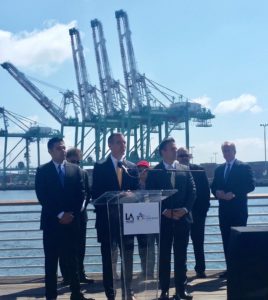On June 12th , the goals for zero-emissions (ZE) goods movement in the Los Angeles Sustainable City pLAn, City of Long Beach Sustainability Action Plan and the California Sustainable Freight Action Plan were all aligned to create a path for action in partnership with labor, business, environmentalists, and community.
The Mayors of Los Angeles and Long Beach supported a vision set forth by community activists like; East Yard Communities for Environmental Justice, Long Beach Alliance of Children with Asthma and End Oil who continue to advocate for a cleaner and safer community demanding a zero emissions goals.
The Joint Executive Directive commitments are as follows:
1. Commitment to advancing clean technology
2. Expand at berth emissions reductions
3. Drayage truck test pilot
4. Expand technology advancement programs
5. Timeline, process and communications
6. CAAP implementation advisory
7. Green Ports Collaborative
8. Secure Funding
What this means is that front line communities, those who suffer the disproportionate burden of port emissions and goods movement diesel exhaust, are ensured that reducing emissions exhaust does not have to come at a cost to the economy or the environment. As Garcetti, the Mayor of Los Angeles, stated, “This is not just a place where the air we breathe affects our children’s lungs, and impacts the health of one another, but 1-9 jobs are here and that has an effect on the communities here too. Our interests are aligned…are not mutually exclusive, we can include good health and a healthy economy together”.
Healthy communities can prosper while keeping jobs and the supply chain optimization necessary to maintain a safe and economically viable future in today’s ports. Together the San Pedro Bay ports account for forty percent of the goods that come by sea into this country.
The agreement directs ports to develop a pilot program to test 50-100 ZE trucks to stimulate market demand, develop emissions control systems, expand technology advancements that support emissions reductions in goods movement industry and finally establish a national Green Ports initiative to advance similar goals along the West Coast.
While it is significant that commitments have been made by the Mayors. The next steps are the toughest. First let’s consider who will be doing the enforcement and second what is the plan to secure funding? One of the repeated themes throughout the presentation from port staff and city officials was that we have a long way to go in terms of meeting the air quality standards and by no means is this a done deal. Nevertheless, we are headed in the right direction and Coalition for Clean Air will continue to work with the ports, community and all stakeholders to reach our air quality goals.
[share title=”Share This Post”]








